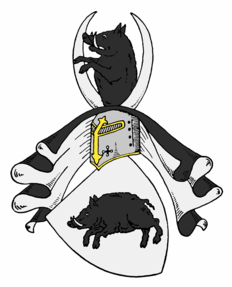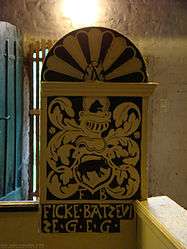Bassewitz

Bassewitz is a German family of ancient nobility whose roots come from the Mecklenburg region. According to tradition, the family was named after the village of Basse (currently a district of the municipality of Lühburg). In German hunter-language, Basse refers to a tusker or adult male wild boar. A Tusker Courant is the family's heraldic animal.
History
Earliest references to the family include a document that dates from 1254, in which Bernhardus de Bassewicze is mentioned. Another document from 1308 mentions a certain Heinrich von Bassewitz. The family is split into two branches – the Mecklenburgian branch and the Wendish branch. It is believed that both branches divided in the 14th century, and that their common progenitor is Hans von Bassewitz on Hohenluckow manor († 1397). The Mecklenburgian branch had estates in the territory of the Duchy of Mecklenburg while the Wendish branch had its estates in the former "Principality of Wenden". Lühburg, Basse, Dalwitz (today a district of the municipality of Walkendorf) and Prebberede were estates of the Wendish branch. All current male members of the Wendish branch are descendants of Count Henning Friedrich von Bassewitz (1680–1749), who was awarded with a hereditary imperial countship (Reichsgraf) in 1726 by Emperor Karl VI for his diplomatic services. All legitimate male-line descendants of Count Henning Friedrich bear the name Graf von Bassewitz (Count von Bassewitz).

Four descendants of Count Henning Friedrich von Bassewitz held the highest office (prime minister) in Mecklenburg:
Count Carl Friedrich (1720–1783) – President of the Privy Council
Count Bernhard-Friedrich (1756–1816) – President of the Privy Council
Count Henning Karl Friedrich (1814–1885) – President of the Privy Council
Count Karl (1855–1921) – President of the State Ministry of Mecklenburg-Schwerin from 1901 through 1914.
Elevations and Additions to the Coat of Arms
Counts von Bassewitz
Hereditary imperial countship – Vienna, 9 June 1726 – granted to Henning Friedrich von Bassewitz. Incorporated into the Estonian Noble Corporation as of 29 January 1725.
Counts von Bassewitz-Levetzow
Bassewitz-Levetzow is a Prussian sub-branch of the comital branch originating from a unification of coat of arms and name with the Levetzow family linked to the fideicommissum of Kläden manor. This was granted in Baden-Baden to Count Karl von Bassewitz on 2 October 1869. Incorporation into Prussian nobility was granted in Berlin on 7 November 1884 to his son and heir, Count Bernhard von Bassewitz. The last person to bear the name of a "Count von Bassewitz-Levetzow" is Count Georg Werner (*1925).
Prominent members of the family

- Count Henning Friedrich von Bassewitz (1680–1749), on Prebberede manor etc., Imperial Privy Councillor of the Russian Empire and of the Holy Roman Empire, President of the Privy Council and Chief Court Marshall of the Duchy of Holstein-Gottorp, President of the Privy Council of the Duchy of Mecklenburg-Schwerin, recipient of the Order of St. Andrew
- Friedrich Magnus von Bassewitz (1773–1858), District President of Potsdam 1810 through 1848, Upper President of the Province of Brandenburg, Honorary citizen of Berlin and Potsdam
- Gerdt von Bassewitz (1878–1923), writer
- Countess Ina Marie von Bassewitz (1888–1973), spouse of Prince Oskar of Prussia
- Werner Graf von Bassewitz-Levetzow (1894–1964) was a German officer in World War II
|